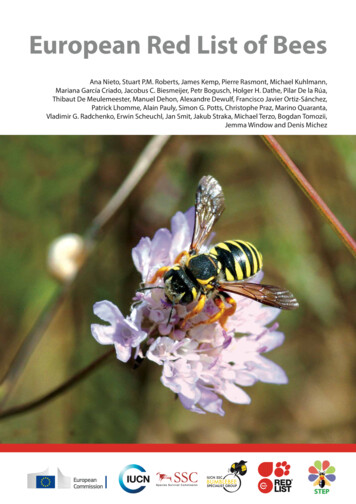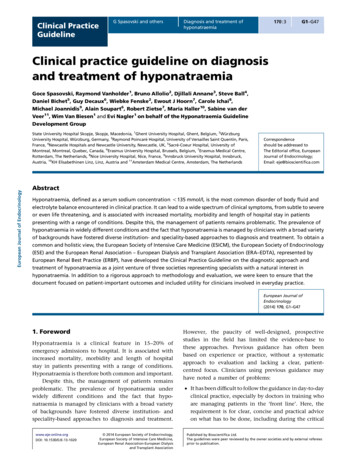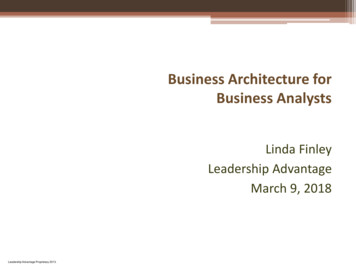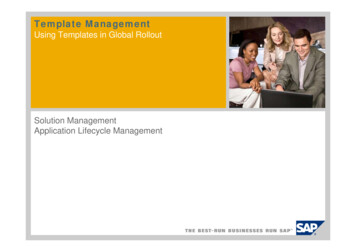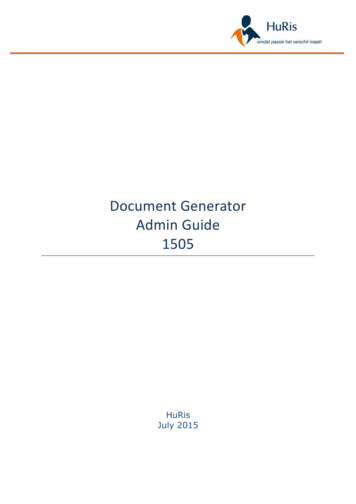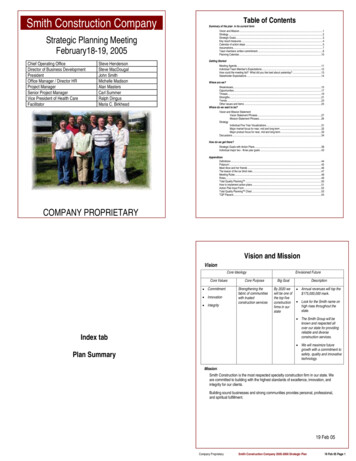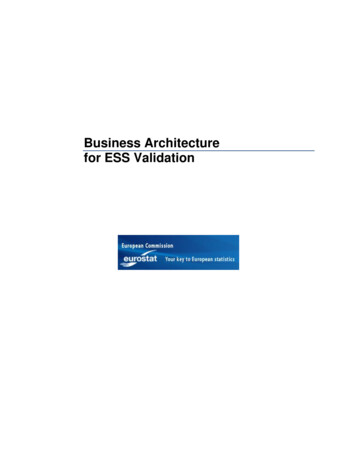
Transcription
Business Architecturefor ESS Validation
Table of Contents1.0 Introduction . 11.1Purpose . 11.2Reader . 12.0 Context . 22.1Scope . 22.2Drivers for change . 23.0 Objectives . 33.1Vision for ESS validation. 33.2Target business capabilities. 44.0 From As-is to To-be . 64.1Current State Business Architecture . 74.2Target State Business Architecture . 124.3Gap analysis . 174.4Roadmap . 205.0 Glossary . 22i
1.0 Introduction1.1PurposeIn January 2013, the ESSC launched the ESS.VIP Validation project in order to startmodernising the way data validation is performed in the ESS. This modernisation will require theintroduction of changes along different dimensions (e.g. methodology, information standards, ITsolutions, business processes etc.). In order to manage the resulting complexity, it is imperativeto have a clear overview of the relationships between these different layers and of how theycombine to achieve the medium-term goals for validation in the ESS.This Business Architecture document delivers this overview. According to TOGAF, a widelyused reference framework for Enterprise Architecture, the Business Architecture “describes theproduct and/or service strategy, and the organizational, functional, process, information, andgeographic aspects of the business environment”. Its purpose is to provide a commonunderstanding of a change initiative and of the way it will impact current business processes: itidentifies the changes an initiative aims to realize and translates them into a blueprint forconcrete implementation. In order to accomplish this, the current document comprises severalparts: Chapter 2 summarises the drivers for the modernising validation in the ESS. It alsospecifies the scope of this modernisation initiative.Chapter 3 defines the medium-term goals for validation in the ESS by identifying themain capabilities to be developed. It also contextualises these capabilities in theframework of the overarching ESS modernisation strategy as outlined in the ESS Vision2020.Chapter 4 shows how the current situation will need to be changed in order to achievethe target capabilities identified in Chapter 3. It outlines the to-be state for validation inthe ESS and analyses the gaps between the current and to-be states.This Business Architecture document follows the approach and principles set out in the ESSEnterprise Architecture Reference Framework (ESS EARF). When relevant, special attentionhas been given to ensure that the content of the Business Architecture is aligned with widelyused reference standards such as GSBPM and GSIM.1.2ReaderThe current Business Architecture document is designed to be a high-level communication toolon the objectives of the ESS.VIP Validation project and on the changes it aims to produce in theway validation is performed in the ESS. The intended audiences are therefore ESS businessand IT managers.It should be however noted that some of the terminology used in this document is specific to thefield of enterprise architecture and may sound foreign to readers who are not familiar with thisdiscipline. Throughout the document, great care has been taken to define and explain technicalterms when necessary. Moreover, a short glossary has been included at the end of thedocument. We refer the reader to the ESS EARF for more in-depth explanations.1
2.0 Context2.1ScopeAccording to the UNECE's Glossary on Statistical data editing, data validation is "an activityaimed at verifying whether the value of a data item comes from the given (finite or infinite) set ofacceptable values." Data validation focuses on the detection of errors in the data and is adistinct activity from data editing and data imputation, which focus on their correction.One of the defining characteristics of the production of European statistics is the fact that theproduction process is distributed across several organisations. Data collection and a first roundof processing are under the responsibility of ESS Member States. The data are then transmittedto Eurostat, where the data are processed further and finally disseminated at European level.Data validation activities occur at several points in this statistical production chain. However,one key step in the ESS statistical production is the validation of the data sent to Eurostat byMember States. This is the step that ensures that the data coming from different nationalauthorities abide by common consistency and coherence requirements and is thus essential inturning national statistics into European statistics. This is the step that this BusinessArchitecture document concentrates primarily on.While the focus of this business architecture is the validation of the data sent by Member Statesto Eurostat, the involvement of Member States in all stages of implementation should ensurethat the solutions outlined in this document can also be used by Member States to modernisevalidation processes in their national environments.The continuous line represents the scope of this business architecture. Some solutions couldhowever be reused outside this original scope, as represented by the dotted line.2.2Drivers for changeThe validation of data sent by Member States to Eurostat is a joint effort involving both nationaldata providers (i.e. NSIs or other national administrations) and Eurostat. Together, these2
organisations must ensure that the coherence and consistency of the data they exchange is inline with expected quality standards. The overall quality of the ESS data validation process istherefore heavily dependent on the quality and depth of the collaboration between Eurostat andnational data providers.While they vary considerably between different domains, current validation practices exhibitshortcomings which could be corrected through strengthened collaboration. The main suchshortcomings are listed below:1. In several domains, the lack of a clear repartition of validation responsibilities among thedifferent partners involved in the production process leads to double-work in the ESSand to the risk of "validation gaps", i.e. to cases where essential validation proceduresare not carried out by any of the actors.2. The lack of shared and easily accessible documentation on validation procedures canlead to time-consuming misunderstandings between Eurostat and ESS data providerswhen data validation problems arise (this phenomenon has been dubbed "validationping-pong"). It can also lead to difficulties in assessing whether the quality assurancemechanisms applied to data sent to Eurostat are "fit-for-purpose".3. The lack of common standards for validation solutions leads to a duplication of ITdevelopment and integration costs in the ESS. Moreover, the ESS is currently incurringhigh opportunity costs by not exploiting the general trend in the IT world towardsService-Oriented Architecture (SOA) and its potential benefits in terms of reuse andsharing of software components.3.0 Objectives3.1Vision for ESS validationThe drivers for change identified in the previous chapter highlight the flaws in the currentvalidation process for the data sent to Eurostat by Member States. The following visionstatement articulates the response to these drivers and provides a compact description of thegoals for validation in the ESS.Response to drivers 1 and 2Establish a transparent business process for validation in the ESS and support it via anintegrated IT architecture allowing for the sharing and reuse of validation services among ESSmembers.Response to driver 3The vision statement above represents a translation of the general ESS Vision 2020 goals intovalidation-specific goals. In particular, as highlighted by the quotes below, the modernisation of3
data validation in the ESS will contribute to the implementation of two ESS Vision 2020 keyareas: quality and efficient statistical processes.“We will further enhance the existing approach to quality assurance withappropriate and effective quality assurance tools for all elements of thestatistical life cycle.”ESS Vision 2020, Key area: Quality“We will intensify our collaboration by further intensifying the sharing ofknowledge, experiences and methodologies but also by sharing tools, data,services and resources where appropriate. The collaboration will be basedon agreed standards and common elements of technological and statisticalinfrastructure.”ESS Vision 2020, Key area: Efficient statistical processes3.2Target business capabilitiesThis Business Architecture document follows an approach based on business capabilities todescribe the changes the modernisation of ESS validation will bring about. Business capabilitiesexpress what an organisation wants to be able to do in the future. Achieving them requires acombination of five dimensions: human resources, methodology, information standards, IT andprocesses/governance.CapabilityHRMethods Processes/GovernanceITStandardsOur approach uses business capabilities as a simple yet powerful conceptual tool to show howthe realisation of the business objectives will impact different aspects of an organisation. Thefirst step is to determine the target business capabilities. These can be extracted from theprevious section's vision statement. The table below formulates these two, validation-specificcapabilities and maps them to the ESS EARF’s Business Capability Model in order to correctlyposition them in the context of the Vision implementation portfolio.4
Target capabilitiesCapability 1: Ability to ensure theCapability 2: Ability to share and reusetransparency of the validation proceduresvalidation services across the ESS on aapplied to the data sent to Eurostat by thevoluntary basis.ESS Member States.Mapping to ESS EARF capabilitiesDesign production system, statisticalprocessing services and rulesProcess & Workflow designExpected benefitsIncrease in the quality and credibility ofEuropean statisticsReductioninITdevelopment costsmaintenanceandReduction of "validation ping-pong"4.0 From As-is to To-beThe following sections will be dedicated to outlining the as-is and to-be states for ESSvalidation. The description of the as-is and to-be states will rely on the identification of thedifferent Business Functions involved in the ESS validation process.According to the definition provided by GSIM, a Business Function is simply "something anenterprise does, or needs to do, in order to achieve its objectives." It is through BusinessFunctions that capabilities are delivered. Business functions will be described in this documentby specifying the involved actors, the GSBPM process step they refer to, their inputs andoutputs in terms of GSIM information objects and the IT services required to support them.The concept of collaboration scenarios will also be used extensively in this section.Collaboration scenarios describe the expected degree of collaboration among ESS members inthe use of IT services. The ESS Enterprise Architecture Reference Framework identifies fourpossible collaboration scenarios: Autonomous: Services are designed and operated without coordination with other ESSmembers;5
Interoperable: ESS members have the autonomy to design and operate their ownservices, as long as they have the ability to exchange information and operate togethereffectively;Replicated: Services are duplicated: ESS members implement an instance of a genericservice in their local environment;Shared: Services are common, shared and accessible to all the ESS members. There isa single instance that is shared and available to all.For all the business process diagrams in this section, the legend below will be used. BusinessFunctions will be marked differently depending on the collaboration scenario of the services thatsupport them. Information objects are also marked differently according to whether or not theyare supported by a standard.BusinessFunctionBusiness Function supported byshared servicesBusinessFunctionBusiness Function supported byreplicated servicesBusinessFunctionBusiness Function supported byinteroperable servicesBusinessFunctionBusiness Function supported byautonomous servicesBusinessFunctionBusiness Function supported byservices in multiple collaborationscenariosBusinessFunctionOut-of-scope Business FunctionInformation Object supported bya standardInformationObjectInformation Object not supportedby a standardInformationObject6
4.1Current State Business ArchitectureAs was mentioned in section 2, the process currently in place for the validation of Europeanstatistics varies from domain to domain, so much so that it could be said that there is not onlyone business architecture for validation in the ESS. The current state business architecturepresented in this section should therefore be viewed as a sort of archetype, i.e. a typical patternto which most domains adhere.The business process diagram in the next page illustrates this archetypal business architecture.In it, Eurostat and Member States define jointly at the Working Group level the structure of thedata to be sent. However, the design and execution of the validation rules to be applied to thedata occur in parallel with little coordination. Each of the Business Functions mentioned in thebusiness process diagram is described in more detail below.Design Data StructureThe first step in the current ESS validation process is the definition of the format of the data filesto be sent to Eurostat. This Business Function is important for validation as it implicitly providesa first set of validation rules related to the expected structure of the data file. This first step isusually conducted jointly by Eurostat and the Member States through consultations in eachspecific domain's Working Group. The main output of this Business Function is a documentdescribing the expected data structure. In recent years, SDMX has played an increasing role instandardising this step. Around 40% of European statistical production processes are nowdescribing their data structures using the SDMX formalism. The emergence of SDMX hasenabled the creation of shared services in support of this Business Function (e.g. the EuroSDMX Registry and the SDMX Global Registry).Business Function NameDesign data structureGSBPM referenceDesign outputs (2.1)Working GroupActorSupporting ITserviceRegistry enabling the creation,management and retrieval of datastructuresDescriptionCollaboration scenarioInputOutputSharedDescriptionN/AGSIM objectN/AStandard availableN/ADescriptionStructure of the datasets to be sent toEurostatGSIM objectData StructureSDMXStandard used7
Current state validation business process in the ESSWorking Group(Eurostat Member States)EurostatMember StatesDesign datastructureGSBPM 2.1DesignvalidationrulesGSBPM 2.5DataStructureDesignvalidationrulesGSBPM 2.5ValidationrulesValidationrulesValidate dataGSBPM 5.3 & 6.2Validate dataGSBPM 5.3 & 6.2ValidationreportAcceptdata?8MSproduction
Design Validation RulesThe second Business Function to come into play is the definition of the rules to be applied tovalidate the content of the data to be sent to Eurostat. Only in a fraction of domains is this stepperformed jointly by Member States and Eurostat at the Working Group level: in most cases,Member States and Eurostat define the validation rules independently and store them in theirown documentation systems. The main outputs of this Business Function are the validationrules themselves. At ESS level, there is currently no standard syntax for validation rules and noshared services to support this Business Function are available.Design validation rulesBusiness Function NameDesign processing & analysis (2.5)GSBPM referenceEurostatActorSupporting ITserviceMember StatesValidation rule documentation systemDescriptionCollaboration scenarioInputOutputAutonomousDescriptionN/AGSIM objectN/AStandard availableN/ADescriptionValidation rulesGSIM objectRuleStandard usedN/AMember State productionAfter the design of the data structure and of the validation rules is completed, Member Statesproduce the required datasets. As already explained in chapter 2, Member State-internalproduction processes are considered to be out of the scope of this business architecture. Thisbusiness function will therefore not be described in more detail.Validate DataThe data sent to Eurostat are validated by both Member States and Eurostat using thepreviously defined data structures and validation rules. Some IT services are offered byEurostat to support this function in Member States (e.g. SDMX Converter, EDIT, Webforms).These are usually deployed as either replicated or shared services. A survey conducted by theValiDat Foundation ESSnet revealed however that in most statistical production processesMember States use their own tools. The main output of data validation is a validation report.Currently, no standardised validation report structure exists in the ESS.9
Validate DataBusiness Function NameReview & validate (5.3)GSBPM referenceValidate outputs (6.2)EurostatActorSupporting ITserviceInput 1Member StatesValidation services executing thepreviously defined validation rulesDescriptionCollaboration scenarioDescriptionStructure of the datasets to be sent toEurostatGSIM objectData StructureStandard availableInput 2OutputSDMXDescriptionValidation rulesGSIM objectRuleStandard availableN/ADescriptionValidation reportGSIM objectProcess MetricN/AStandard used4.2AutonomousTarget State Business ArchitectureStarting from the target capabilities listed in chapter 3, this section will highlight the mainchanges that need to be undertaken in order to realise them. The outcome of this analysis willbe an outline of the target to-be state architecture.Capability 1: Transparency of the validation proceduresIn the as-is business architecture, the main obstacle to the transparency of the validationprocedures applied to the data sent by Member States to Eurostat is the lack of coordination onthe design of the validation rules. As the previous section showed, Member States and Eurostatoften perform this step in parallel and do not communicate the respective validation rules toeach other.In order to guarantee transparency, the "Design Validation Rules" Business Function musttherefore evolve from its current condition. Working Groups should take over the responsibilityto design validation rules and to assign validation responsibilities. In order to support this workand facilitate communication between the different actors involved, a common standard for the10
description of validation rules should be developed and a shared registry of validation rulesshould be created. The table below summarises the changes needed.Design validation rulesBusiness Function NameDesign processing & analysis (2.5)GSBPM referenceWorking GroupActorSupporting ITserviceRegistry enabling the creation,management and retrieval of validationrulesDescriptionCollaboration scenarioInputOutputSharedDescriptionN/AGSIM objectN/AStandard availableN/ADescriptionValidation rulesGSIM objectRuleESS Standard for validation rulesStandard usedCapability 2: Sharing and reuse of validation servicesThe wider sharing and reuse of validation services in the ESS is currently hindered by threemajor factors: The first one is the lack of ESS standards for the main inputs and outputs of the"Validate Data" Business Function. In the target to-be state, validation services shouldbe based on a standard description of validation rules and of validation reports. The second one is the lack of agreement on the correct granularity and scope ofvalidation services. In the target to-be state the validation process should be supportedby a portfolio of reusable ESS validation services, each responsible for a specific subsetof validation (e.g. structural validation, outlier detection, etc ). The third one is the absence of a common IT infrastructure in the ESS to support sharingand reuse. In the target to be state, an ESS infrastructure to enable a plug-and-playapproach to validation should be set up.Taking into account all the needs outlines above, the "Validate Data" Business Function for thetarget to-be state can be summarised as follows.Validate DataBusiness Function NameReview & validate (5.3)GSBPM referenceValidate outputs (6.2)11
EurostatActorSupporting ITserviceInput 1Member StatesGranular validation services executing thepreviously defined validation rulesDescriptionCollaboration scenario ionStructure of the datasets to be sent toEurostatGSIM objectData StructureSDMXStandard availableInput 2DescriptionValidation rulesGSIM objectRuleESS Standard for validation rulesStandard availableOutputDescriptionValidation reportGSIM objectProcess MetricESS Standard for validation reportsStandard usedThe target to-be state resulting from the two changes outlined above is illustrated by thebusiness process diagram on the next page.12
To-be state validation business process in the ESSWorking Group(Eurostat Member States)EurostatMember StatesDesign datastructureGSBPM 2.1DesignvalidationrulesGSBPM e dataGSBPM 5.3 & 6.2Validate dataGSBPM 5.3 & 6.2ValidationreportAcceptdata?13
As long as the jointly agreed upon validation rules are applied, each Member States should beable to freely choose, for each statistical production process, the extent to which it wants tobenefit from the availability of reusable ESS validation services. We can thus delineate threebasic scenarios for how Member States could execute validation rules in the target to-be state.Scenario 1: Autonomous validation servicesUnder this scenario, Member States use their own autonomous services to execute thevalidation rules prior to data transmission to Eurostat. These autonomous services wouldhowever use the jointly agreed upon data structures and validation rules, which would be storedin centrally hosted registries. The translation of these validation rules into the autonomousvalidation services would be the responsibility of each individual Member State.ESS service platformDataStructureRegistryMS productionValidationRuleRegistryTransmission toEurostatProcess OrchestratorValidationService 1ValidationService 2MS environment14ValidationService 3
Scenario 2: Replicated/Shared validation servicesUnder this scenario, in addition to the shared registries for data structures and validation rules,Member States use some replicated and/or shared validation services in their validationprocess. Member States would be free to select the combination of autonomous/ interoperable/replicated and shared services they find most suitable. Member States would remainresponsible for the orchestration of the different services used in the validation process. Thisscenario can be equated with the Software as a Service (SaaS) paradigm in cloud computing.ESS service yValidationService 2MS productionTransmission toEurostatProcess OrchestratorValidationService 1ValidationService 3MS environmentScenario 3: Shared validation processUnder this scenario, Member States would delegate the validation of their data to a centrallypredefined shared validation process. This shared validation process would take care of theorchestration of the various services needed and would return to the Member State acomprehensive validation report. This scenario can be equated with the Business Process as aService (BPaaS) paradigm in cloud computing.15
ESS service yProcess OrchestratorValidationService 1MS productionValidationService 2ValidationService 3Process OrchestratorTransmission toEurostatMS environmentThe scenarios illustrated above represent somewhat idealised situations. In real-life situations, itis probable that Member States will create hybrid scenarios which will incorporate elements oftwo or more scenarios. Each Member State would be free to mix and match the three scenariosas it sees fit.4.3Gap analysisIn this section, the analysis will concentrate on the identification of the capability gaps betweenthe current state and the target state, as described in the previous paragraphs. The analysis willalso determine which elements are needed to fill the identified gaps.Capability 1: Transparency of the validation proceduresThe changes required to achieve this capability concern the "Design validation rules" BusinessFunction. Below is a side-by-side comparison of this Business Function in the current and to-bestates, with the main foreseen changes written in red.16
CurrentBusiness Function NameGSBPM referenceDesign validation rulesDesign validation rulesDesign processing &analysis (2.5)Design processing &analysis (2.5)EurostatActorTo-beMember StatesWorking GroupValidation ruledocumentation systemRegistry enabling thecreation, management andretrieval of validation rulesAutonomousSharedDescriptionN/AN/AGSIM objectN/AN/AStandard available N/AN/ADescriptionSupporting dation rulesValidation rulesGSIM objectRuleRuleStandard usedN/AESS Standard for validationrulesOutputRealising the changes highlighted in the comparison table above implies improvements along allfive of the capability dimensions introduced in Chapter 3. The table below contains the maindeliverables which will need to be provided to adequately cover each dimension.CapabilityDimensionHRCapability1Needed deliverablesTraining and communication on new role of Working Groups andon new standard language for validation rulesMethodological handbook providing common definitions forconcepts important for validation (validation rules, levels, metrics)MethodologyWorking Group templates to be used by Working Groups to definevalidation rulesProcesses/GovernanceITStandardsCommon ESS validation policy focusing on the attribution ofvalidation responsibilitiesValidation Rule Registry and GUIStandard language for validation rules17
Capability 2: Sharing and reuse of validation servicesThe same procedure used to highlight the gaps for Capability 1 can be applied to Capability 2.Here the only concerned Business Function is "Validate Data". The comparison table in thiscase is the following:CurrentValidate DataValidate DataReview & validate (5.3)Review & validate (5.3)Validate outputs (6.2)Validate outputs (6.2)EurostatEurostatMember StatesMember StatesValidation servicesexecuting the previouslydefined validation rulesGranular validation servicesexecuting the previouslydefined validation onomousDescriptionStructure of the datasets tobe sent to EurostatStructure of the datasets tobe sent to EurostatGSIM objectData StructureData StructureBusiness Function NameGSBPM referenceActorSupporting ITserviceInput 1DescriptionCollaborationscenarioStandard available SDMXInput 2SDMXDescriptionValidation rulesValidation rulesGSIM objectRuleRuleESS Standard for validationrulesStandard available N/AOutputTo-beDescriptionValidation reportValidation reportGSIM objectProcess MetricProcess MetricN/AESS Standard for validationreportsStandard usedThe deliverables needed to bridge the identified gaps can once again be classified according tothe five dimensions of Capability 2, as in the table below.18
CapabilityDimensionHRCapability2Training and communication on validation architecture andvalidation servicesMethodologyMethodological handbook providing common definitions forconcepts important for validation (validation rules, levels, metrics)Processes/GovernanceSOA GovernanceITStandards4.4Needed deliverablesSOA Principles and InfrastructureDefinition of needed validation services conforming to thearchitectureDevelopment of needed validation servicesStandard language for validation rulesStandard format for validation reportsRoadmapIn the preceding section, the main deliverables needed to achieve the two target capabilities forESS Validation were listed. While some deliverables contribute to a single capability, otherscontribute to both.The preceding analysis did not highlight the dependencies between the different deliverables.The dependency map on the following page illustrates these dependencies and shows whichdeliverables are currently under development. While a precise roadmap for all the deliverableshas not yet been established, the dependency map shows the sequence that will need to befollowed to fully achieve the target capabilities.DeliverableDeliverable supporting
This Business Architecture document delivers this overview. According to TOGAF, a widely used reference framework for Enterprise Architecture, the Business Architecture "describes the product and/or service strategy, and the organizational, functional, process, information, and geographic aspects of the business environment".

